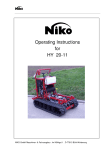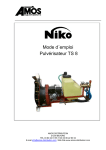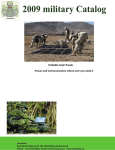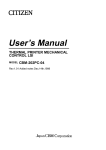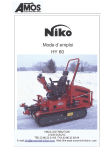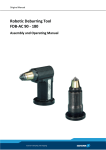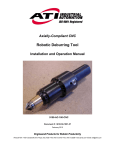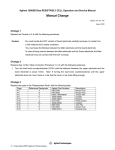Download Operating Instructions for Pruning Machine NIKO I Typ
Transcript
Operating Instructions for Pruning Machine NIKO I Typ 180 / 250 NIKO GmbH Maschinen- & Fahrzeugbau . Im Mühlgut 1 . D-77815 Bühl-Weitenung Introduction Dear customer We would like to thank you for your confidence in purchasing a NIKO product. We did our best to deliver you an efficient and reliable product. We kindly ask you to read the operating instruction as well as to observe all other instructions before starting the machine. This operating instruction will give you detailed information about starting up the machine and about the maintenance. As you know, the warranty does not cover any claims resulting from operating errors or inappropriate use. In case of ordering spare parts, accessories or submitting complaints, it is absolutely necessary to state the following data: Type: Pruning Equipment NIKO I Typ 180/250 Technical Improvements: We are always trying to improve our NIKO products. Therefore we reserve the right to implement all improvements and changes we think to be necessary on our products without further announcement and without obligation of updating machines that are already sold. We are glad to answer any further questions you may have and wish you lots of fun with your new NIKO product. Best regards! N I K O Maschinen- & Fahrzeugbau Dieter Serr, General Manager Index • Product Description 1.) Appropriate use 2.) Construction 2.1) Available accessories 2.2) Spare parts list 3.) Functional description 4.) Technical data 5.) EG-conformity declaration • General Safety Information 1.) Care 2.) Description of the symbols used • Transport 1.) Dimensions and weight • • Help with breakdowns Possible breakdowns and their elimination • Maintenance 1.) Cleaning and lubrication 2.) Servicing 3.) Motor servicing • Warranty conditions Product description 1. Conventional usage The NIKO Pneumatic Pruning Machine is only made for: - the use of Pneumatic tools, which are approved and sold by NIKO (Pneumatic Shears, Hook shears, Hedge cutters, Pruning Saws, Chainsaws and Tree shakers) The machine is not adequate for any operations as the above mentioned – this is considered as inadequate use! 1 2. Construction Wartungseinheit Maintenance unit Handstarteinrichtung Hand launching adjustion Benzinhahn/ Starterklappe Fuel tap / choke Motor Oil dipstick Ölmeßstab Werkzeug-Anschluß Tool connection Schlauchtrommel Hose drum Kompressor Compressor Öleinfüllöffnung Oil charging hole Ölauge Oil eye Pressure tank Druckkessel Discharge screw Ablaßschraube 2.1 Available accessories Spring-driven or hand-rollable Hose reels NIKO Pneumatic Shears and tools (Pruning Saw, Chainsaw, Hook Shear etc.) 2 2.2 Spare Parts List NIKO I Pruning equipment Typ 180 / 250 Art. No. Description Art.-No. 16001 16002 Motor GX 110 Compressor 16024 16025 16003 Pressure reed 16025a 16004 16005 16006 16007 16008 16008a 16008b 16009 16010 16011 16012 16013 16014 16015 16015a 16016 16017 16018 16019 16020 16021 16022 16023 Frame Holder grip Front panell Cover bonnet Take out incl. Niko disc Axial ball bearing Ball bearing Adjusting screw Magnet Fan-stage disc V-belt disc V-belt Belt tensioner (old extender) Wheels Hubcaps Drain spigot Distributor O-Rings Axes chromed Barrell incl. Gear rim Belt incl. Cutterb Hose eye Protection valve 16026 16027 16028 16029 16030 16031 16032 16033 16034 16035 16036 16037 16038 16039 16040 16040a 16041 16042 16043 16044 16045 16046 16047 Description Maintenance unit Maintenance unit holding, new (Aluminium holder) Maintenance unit holding, old (steel sheet holder) LCK-Screwing Hollow screws Overthrowing nut Gaskets Buckling protection feathers Eyelet Coupling Distributor FR 4 Snap hook Connection Connection incl. Buckling protection Connection Connection incl. Buckling protection Oil connector Screws incl. Padding disc Pressure nut Screws incl. nut Screws incl. nut Drain valve Babbitt metal liner Fitting connection Manometer Q 45 Manometer Q 40 3 3. Functional description Before starting the pruning machine: 1.) Control the motor oil 2.) Check the compressor oil stand 3.) Check the stand of oil in the maintenance unit 4.) Discharge the water in the waterprecipator of the maintenace unit 5.) Check the stand of fuel 6.) Discharge overpressure from the pressure tank with the drain screw To start the pruning machine: 1.) Close the choke if the motor is cold 2.) Open the Fuel tap 3.) Pull out the starting control slightly until you note some resistance, then pull through zestfully and pull the control back 4.) Close the choke again 5.) Attach pneumatic tools While working with the pruning machine: 1.) Check the stand of oil in regular intervals (approx. each 5 hours) 2.) Discharge water in the waterprecipator of the maintenance unit in regular intervals (approx. each 3 hours) 3.) Discharge water at the drain screw of the pressure tank daily 4.) At machines with automatic return Hose reel always wind up controlled After working with the pruning machine 1.) Check the motor oil 2.) Check the stand of Compressor oil 3.) Check the stand of oil in the maintenance unit 4.) Discharge the water in the waterprecipator of the maintenance unit 5.) Check the stand of fuel Discharge overpressure from the pressure tank with the drain screw Storing of the pruning machine: - Frost proof - Warm (makes the starting easier) - Dry Operation of the maintenance unit (Filterpressurereducer and Oiler) 1.) Maintenance units consisting of Filterpressureducer and Oiler have the function to clean the compressed air as equipment of liquid and solid components, to regulate the air-pressure and to aerate the air with oil covered in the finest smoke screen to lubricate cylinders. If they are used the right way (corresponding to the operating conditions) they remain at the level of efficiency and advance the durability. 1.1) Filterpressurereducer (Filter) The compressed air contains condensation water, tube scales, pieces of rust and similar things that corrode and disturb the function of the pneumatic controlled tools, pressure cylinders, valves etc. For that reason the cleaning of the compressed air is necessary and gets caused by the filter. The degree of cleaning depends on the pore width of the Sinter filter. If desired the Sinter filter can be installed with less pore width. Maintenance: Discharge condensation water regularly and clean the Sinter filter if it is dirty. Demounting: Release screws, take of the container, release the nut of the Sinter filter, take out the Sinter filter. Place the Sinter filter in solvent (for example fuel) pivot well and dry it, then reinstall it. Please pay attention to a faultless sealing. Cleaning of the plastic containers. 4 1.2) Pressure Reducer: Very Important, please take note of it: The top cover toggle screw has to be released at the end of the season. The line pressure of a compressed air machine is unsteady and 2 depends on the size of the compressor (10-16Kp/cm ). Pressure reducers reduce this unsteady line pressure (primary pressure) to the desired working pressure (secondary pressure) and keep it constant. For Maintenance units Filter pressure reducers with return control are used. Filter pressure reducers with return control have the advantage, that it is possible to reduce the secondary pressure without discharge of air but by turning back of the regulation screw. Furthermore the backstrokes, that appear at pneumatic controls get conducted in the atmosphere by back control which can also be counted as a safety valve, this procedure protects the Manometer. Pressure setting: Before launching the air line, discharge the filter pressure reminder by unscrewing the regulating screw. Then turn in the regulating screw in clockwise direction until the Manometer shows the working pressure desired at the Pressure Reducer. 1.) Fogoiler: The compressed air gets concentrated by the fogoiler with a fine oilfog and effectuates in this condition a continuous and steady lubrication of pneumatic controlled compressed air tools, cylinders, 2 valves etc. Please Note: Minimum working pressure 0,5 kp/cm . The fogoilers work correspondant to the working pressure with minimum air consumption. This minimum air consumption was measured with an oil of 2,8° E (50°C) Proportioning: Regulate the amount of oil (approx. 1 drop per 30 shear strokes) while working with the machine at the proportioning screw as desired. The amount of drops can be seen in the glass sight funnel. Filling in of the oil: Remove the fill in screw, fill the container until the fill in mark (approx. 2/3). Close the fill in screw well. It is possible to refill the oil while working with the machine, the air supply does not have to be stopped. The cleaning of the plastic containers is only permitted with water, petroleum or cleaning solvent. 2.) Setting up the amount of oil: Adjust in clockwise direction „less oil“ In counter clockwise direction „more oil“ ATTENTION MORTAL DANGER !!! NEVER MANIPULATE AT THE OVERPRESSURE VALVE OR THE FREEWHEEL VALVE !!! Maintenance and Reparations should only be made from professional shops. 4. Technical Information - 4 or 5,5 PS Honda-Motor (GX 160 / GX 270) with automatical oil stopping 1-rotor-compressor with 180 or 250 liter air capacity Working pressure until 16 bar Automatical Oil warning system Freewheelvalve ( Automatical disconnection ) Maintenance unit (Air filter, Pressurereminder, Fogoiler) Connection for 1-2 shears Measurements and Weights Height: Width: Depth: Weigth: 92 cm 68 cm 65 cm 52 Kg 5 EG-Conformity Declaration according to II A of EG machine guidelines (89/392/EWG) The manufacturer: NIKO GmbH Maschinen- & Fahrzeugbau Im Mühlgut 1 D-77815 Bühl-Weitenung Germany declares, that the machine described as follows: NIKO I Pruning machine Type 180 Economy Machine No. complies with the safety and health requirements of the following EG-guidelines: EG-Machine Guideline 89/392/EWG Version 93/44/EWG Harmonized standards applied: DIN EN 292 Safety of machines: Teil 1 Basic definitions, general design guidelines Teil 2 DIN EN 294 DIN EN 349 Technical guidelines and specifications Safety distances to avoid contact of upper body parts with dangerous area Minimum distance to avoid the pinching of body parts Machine safety, emergency stop device DIN EN 418 DIN EN 60204 Machine safety; general requirements for electrical machine equipment This conformity declaration is voided by constructive changes, affecting both technical data stated the operating instruction and appropriate use, altering the machine significantly! Bühl, 11.10.12 Dieter Serr, General Manager 6 General Safety Information Operator’s care The NIKO c pruning machine was designed and constructed under consideration of a threat analysis and after an accurate selection of the maintained norms as well as well as some further technical specifications. That accords to the state-of-the-art and guarantees a maximum safeness. That safeness can just be obtained when all necessary measures are considered. It is the liability of the operator to arrange these measures and to control their execution. The operator has to make sure, that ... - the shear has to be used according to the regulations (see chapter „Product Description“) the shear will only be operated in a proper and fully functional condition all necessary protective equipments for the operator are at your disposal and are used as well the operation instruction is in a legible condition and is available at the location only adequate qualified and authorized persons work with the machine, repair and maintain it the employees are always able to answer all the questions concerning job safety and environmental protection and also get instructed about it regularly the operator wears a safety glove all safety information which are applied to the machine are not being removed and that they stay legible the advices in this manual as well as the general valid safety and accident precaution regulations are followed before starting to work with the machine you have to make sure, that you know about all of the equipment and the operating elements, as well as their function. While working with the machine it is too late! the clothing of the operating staff should suit closely. Loose worn clothes should be avoided. - before starting the machine the close up range is checked (CHILDREN !!!) - you do not leave the motor working in closed rooms (POISONING)! - while working with fuel you have to be very cautious because there is a high Fire danger!!! the fuel is never refilled next to unshielded flames or ignitable sparks no one smokes while refuelling!!! the motor is stopped before refuelling. Do not refill the fuel in closed rooms. submerged fuel is removed instantly (Fire danger) the machine is kept clean to avoid fire danger before start working with the machine the operating reliability is checked! the pruning machine is only used by persons that are in a mental and physical acceptable condition, before and while working with the machine it is not allowed to consume pills or alcohol the machine is not being used from persons that are underage the machine is secured against rolling away the pruning machine is never unattended while the motor is still working the machine only gets started if all protection devices are installed and are in protection setting - - 7 MAINTENANCE 2. Explication of the safety symbols used In the manual for this machine, the following safety symbols are used. These symbols are there to call the readers attention to the text of the adjoining security advice. These symbols point out that there is a risk for the life and health of persons working. Fire danger! Risk of suffocation! No smoking! Fire danger! This symbol points out, that there is a danger for the machine, the material or the environment and marks the information that help to understand the functions of the machine better. Transport To avoid damages at the machine or injuries while the transport it is essential to respect the following items: - transport workings are only allowed to be made if the security advices are followed - the machine can only be hoisted or fixed at the holding points which are made therefore - do not transport the machine horizontal Help with breakdowns To avoid engine troubles or life-threatening injuries while fixing breakdowns at the machine, it is necessary to respect the following items: - only fix a breakdown if you have the desired qualification - secure the machine against rolling away and an unintended restart - assure at all times a safety shut down of a second person - secure the action area of the flexible parts of the machine - also read the chapter „General Safety Information“ Tabular overview of possible fault reports and help for fixing of the breakdowns Reason Correction Machine does not start • Motor can only be pulled through badly • • • • Machine does not produce any pressure • • • Engine fuel supply - open the fuel tap - fill in the fuel Check the stand of oil and refill it if necessary Adjust the ignition switch on 1 Close the choke Discharge the air at the pressure tank using the drain screw Drain plugs are closed (Maintenance unit, pressure tank) Check the v-belt Check the hoses and pipes on breakdowns 8 MAINTENANCE Maintenance To avoid engine troubles or injuries during the maintenance of the machine it is essential to respect the following items: - All working steps have to be mandatorily made in the stated order Secure the maintenance area in a wide range Switch all units of pressure at zero pressure Only use the stated operating materials Only use the spare parts that are mentioned in our spare part lists Also read the chapter „General Safety Information“ 1. Cleaning and lubrication • • • Clean the filters of the maintenance unit at the end of the season Clean the air strainer of the compressor after each 50 operating hours Clean the motor air filter according to the motor guide 2. Maintenance • Check the tension of the v-belt Motor maintenance • Please respect the guide of the motor manufacturer for this topic • Do not do any maintenance while the motor is working • Only refill the fuel if the motor is switched off • Attend the required quality of oil and fuel and only store them in the containers that are therefore allowed • Pay Attention while discharging hot oil – Burning danger • Dispose discharged oil in proper form • Reinstall the protection devices after the maintenance 9 Warranty NIKO-products are built using modern manufacturing technologies with a maximum of care, subjected to numerous quality controls. This is why NIKO offers a 12 months warranty, if the following conditions are met: 1.) The warranty starts at the day of purchase 2.) The warranty includes material and manufacturing defects. For subsupplier parts (hydraulics, electronics, engine) we are only responsible to the extend of the warranty of the respective subsupplier. During the warranty period fabrication and material defects are handled free of charge by replacement or refitting of parts in question. Others, further claims, such as trade, discount, or damage compensation not concerning the delivered products are explicitly excluded. Warranty claims are exclusively handled by authorized repair shops, NIKO-manufacturing representatives, or the manufacturer. 3.) Excluded from the warranty are damages due to wear, soiling, corrosion, and all faults caused by inappropriate use and its consequences. Also, unauthorized repairs or changes of original conditions void the warranty. No recovery of damages is possible if spare parts other than original NIKO-parts are used. Therefore, please pay special attention to the operating instructions. Direct any questions you may have to our manufacturing representatives or directly to the manufacturer. Warranty claims have to be submitted to the manufacturer within 30 days form the date of damage. Please provide the date of purchase and the machine number and use the warranty form provided. Warranty repairs can only be carried out by an authorized repair shop, after consulting with NIKO. Please advise your repair shop accordingly. Repairs done under warranty do not extend the warranty period! Faulty transport is not a manufacturing fault, and therefore, is not the responsibility of the manufacturer. 4.) Claims for damages other than on the products itself are excluded. This includes liability for damages resulting from operating error. Unauthorized modifications to the product can lead to damages and release the shipper from any responsibility for these damages. 10













